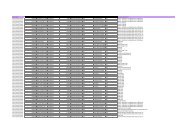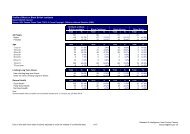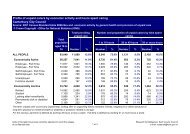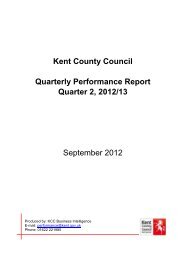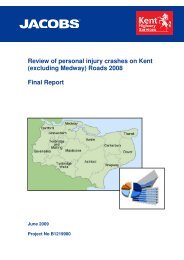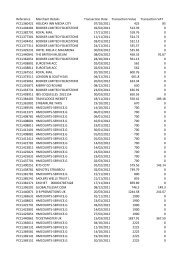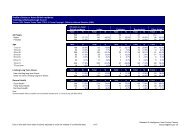Benenden Walk - Walk Through Time
Benenden Walk - Walk Through Time
Benenden Walk - Walk Through Time
You also want an ePaper? Increase the reach of your titles
YUMPU automatically turns print PDFs into web optimized ePapers that Google loves.
<strong>Benenden</strong> School<br />
<strong>Benenden</strong> School was originally at<br />
the centre of the Hemsted Estate<br />
(meaning homestead), which was<br />
granted to Richard Guldeford by King<br />
Richard II. It has an even more ancient<br />
history – a Roman settlement was<br />
discovered in the school grounds<br />
in the 1950s, at the intersection<br />
of Roman roads. The seat of Lord<br />
Cranbook, the house was rebuilt in<br />
1860, and expanded further in 1912<br />
by Lord Rothermere. The school was<br />
founded in 1923, and was attended by<br />
the Princess Royal.<br />
On the site of the old Toll House is the<br />
Queen’s Well, built to celebrate Queen<br />
Victoria’s Jubilee. Opposite the village<br />
green is Gibbon’s School, built in 1609<br />
by Edmund Gibbon, a clothier and local<br />
benefactor. The school is still in use.<br />
Turn right at the village green and head<br />
towards St George’s Church. There has<br />
been a church on this site since 1086,<br />
when it was listed in the Domesday<br />
Book. However, its roof was set alight<br />
during a storm in December 1672, and<br />
the church was destroyed, to be rebuilt<br />
in 1677. Its present interior owes much<br />
to Lord Cranbrook, who redesigned it in<br />
1861. If you have time, look inside the<br />
church and find the millennium tapestry<br />
on the right as you enter through the<br />
main door.<br />
From the church steps, bear left<br />
through the churchyard and go through<br />
the gate, keeping the field boundary on<br />
your right. Pass over stiles and through<br />
gates. Bear right, keeping on the High<br />
Weald Landscape Trail heading south<br />
and noting the wonderful views towards<br />
Hastings and Fairlight. Pass a pond on<br />
your right, and when you reach the track,<br />
turn right, and after a short distance<br />
climb over the stile taking the footpath<br />
left across the fields to Strawberry Wood.<br />
Pass through the gate and continue down<br />
a woodland track towards the ancient<br />
Strawberry Wood Culvert, which was fully<br />
restored in 2009.<br />
Short cut (avoiding Strawberry<br />
Wood Culvert)<br />
Bear right before the church and follow the<br />
lane around the churchyard, then into a<br />
paddock and follow the path over a series<br />
of stiles down to the road. Cross over the<br />
road and follow the grass track down to the<br />
entrance gate of Stream Farm.<br />
Strawberry Wood Culvert<br />
Long <strong>Walk</strong> (via Strawberry Wood<br />
Culvert<br />
From the culvert, follow the path down<br />
to the lane, taking the time to admire the<br />
historic boundary on the left as you emerge<br />
from the wood. Turn right when you reach<br />
the lane, taking care as you walk up it. At the<br />
top of the hill is the 17th century Woodcock<br />
Inn; a fine halfway house serving quality<br />
food and beers.<br />
Opposite the pub, the path leads along a<br />
track by the side of a wood, past the sewage<br />
works and up through an orchard. At the top<br />
of the orchard, bear left along the boundary<br />
of the houses until you reach the road. Turn<br />
right and walk down the pavement until you<br />
reach the footpath straight ahead where the<br />
road bends to the left. <strong>Walk</strong> straight across<br />
a field until you reach a track and go up it a<br />
short distance before turning left, following<br />
the line of the fence. The path emerges at<br />
a surfaced footpath, where you turn right<br />
up the hill, and walk back up towards St<br />
George’s Church. Follow the path as it turns<br />
back on itself through a paddock over a<br />
series of stiles down to the road, taking<br />
in the view of the countryside towards<br />
Cranbrook. Cross over the road and follow<br />
the grass track down to the entrance gate of<br />
Stream Farm.<br />
Follow the path right over a stile and<br />
below the boundary of the farm. Go through<br />
a gate, bear right through a field and up<br />
to a stile. Climb over the stile and you will<br />
emerge above Scullsgate House. Turn left<br />
on to the road – a historic drove routeway<br />
and lane. Turn right down the road and<br />
take the left-hand fork, until you reach<br />
Little Nineveh.<br />
Nineveh was an ancient Middle Eastern<br />
city, founded by the Assyrians, and is<br />
now Mosul, in Iraq. In the book of Jonah,<br />
in the Bible, Nineveh is depicted as “a<br />
wicked city worthy of destruction”. It<br />
is possible that the name is linked to<br />
the properties owned in the past by<br />
Dissenters – people who split from the<br />
established Church.<br />
Beyond Little Nineveh take the<br />
footpath on the right that travels up the<br />
hill and through the edge of the wood.<br />
Continue on through the fields up to the<br />
road and turn left. After approximately<br />
100 metres, at the corner of the road,<br />
take the footpath that leads across the<br />
fields towards Swattenden, following the<br />
hedge on your left. Pass the pond and<br />
look for a gap in the hedge, where you<br />
turn right. Follow the hedge-line to a gap<br />
and go over the footbridge through a<br />
small orchard. Bear left to another gap in<br />
the hedge, then go around the corner of<br />
the field to the road. Cross the road with<br />
care. Go into a copse and follow the path<br />
on the right edge of the field until you<br />
reach a waymark pointing left across the<br />
field. Follow the line to meet a hedge and<br />
continue walking, keeping the hedge on<br />
your right. Go through into the next field<br />
and bear left. This will bring you on to a<br />
track travelling past The Freight.<br />
The Freight is a historic farmstead<br />
dating back to the 15th century,<br />
although it is thought there may have<br />
been a farm on the site before the<br />
1400s. The house was rebuilt in the<br />
16th century, and in 1675 the owner,<br />
Richard Road, was fined £20 for holding<br />
a Presbyterian meeting in his house.<br />
Continue along the track past Mount<br />
Ephraim (a house whose name may refer<br />
to an owner who was also a Dissenter),<br />
and at the top of Freight Lane bear left, go<br />
down an alleyway and out into the Crane<br />
Valley. Follow the path through the valley<br />
towards the High Street, and turn right.<br />
You will find yourself back at the Weald<br />
Information Centre.





